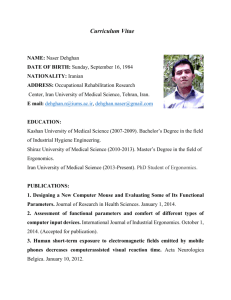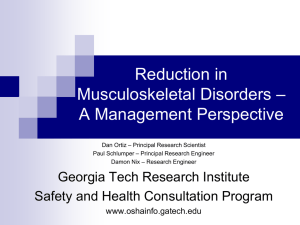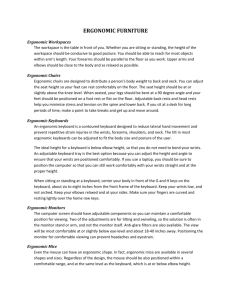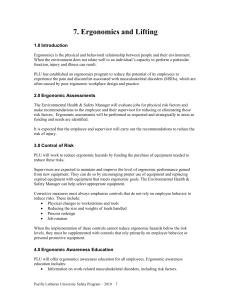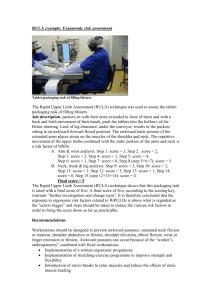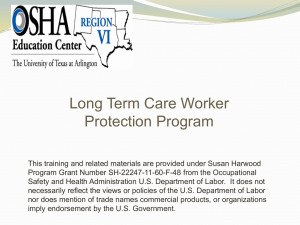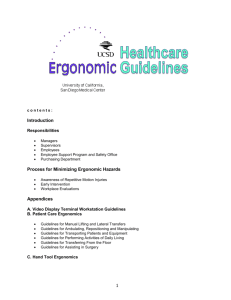Word doc - Michigan Municipal League
advertisement
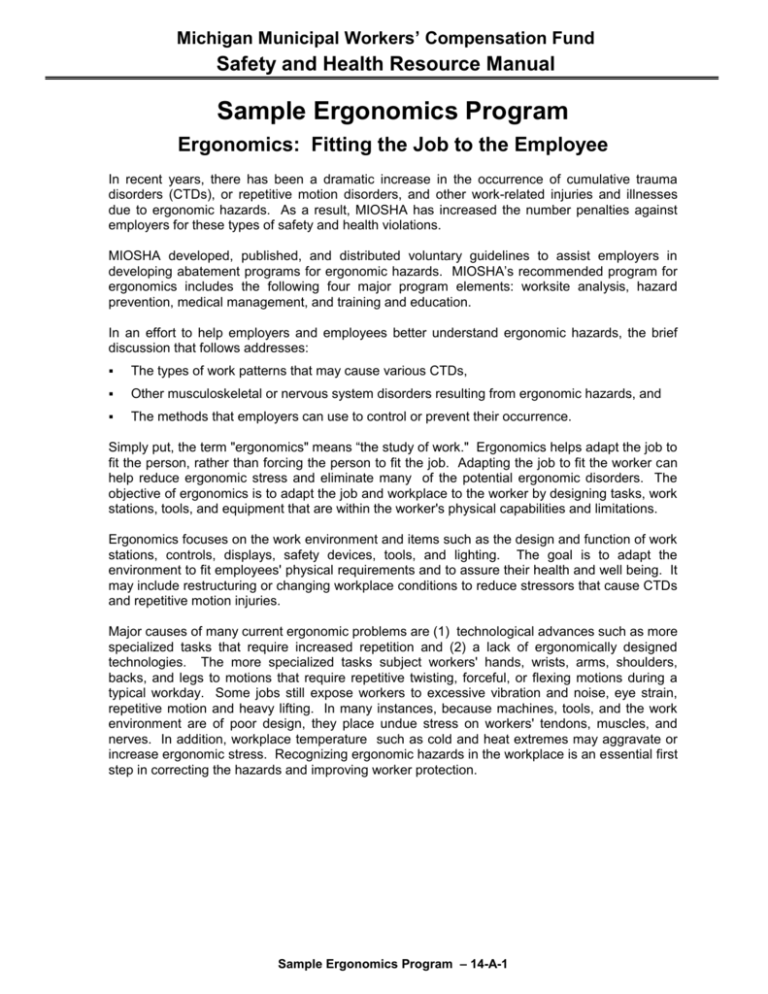
Michigan Municipal Workers’ Compensation Fund Safety and Health Resource Manual Sample Ergonomics Program Ergonomics: Fitting the Job to the Employee In recent years, there has been a dramatic increase in the occurrence of cumulative trauma disorders (CTDs), or repetitive motion disorders, and other work-related injuries and illnesses due to ergonomic hazards. As a result, MIOSHA has increased the number penalties against employers for these types of safety and health violations. MIOSHA developed, published, and distributed voluntary guidelines to assist employers in developing abatement programs for ergonomic hazards. MIOSHA’s recommended program for ergonomics includes the following four major program elements: worksite analysis, hazard prevention, medical management, and training and education. In an effort to help employers and employees better understand ergonomic hazards, the brief discussion that follows addresses: The types of work patterns that may cause various CTDs, Other musculoskeletal or nervous system disorders resulting from ergonomic hazards, and The methods that employers can use to control or prevent their occurrence. Simply put, the term "ergonomics" means “the study of work." Ergonomics helps adapt the job to fit the person, rather than forcing the person to fit the job. Adapting the job to fit the worker can help reduce ergonomic stress and eliminate many of the potential ergonomic disorders. The objective of ergonomics is to adapt the job and workplace to the worker by designing tasks, work stations, tools, and equipment that are within the worker's physical capabilities and limitations. Ergonomics focuses on the work environment and items such as the design and function of work stations, controls, displays, safety devices, tools, and lighting. The goal is to adapt the environment to fit employees' physical requirements and to assure their health and well being. It may include restructuring or changing workplace conditions to reduce stressors that cause CTDs and repetitive motion injuries. Major causes of many current ergonomic problems are (1) technological advances such as more specialized tasks that require increased repetition and (2) a lack of ergonomically designed technologies. The more specialized tasks subject workers' hands, wrists, arms, shoulders, backs, and legs to motions that require repetitive twisting, forceful, or flexing motions during a typical workday. Some jobs still expose workers to excessive vibration and noise, eye strain, repetitive motion and heavy lifting. In many instances, because machines, tools, and the work environment are of poor design, they place undue stress on workers' tendons, muscles, and nerves. In addition, workplace temperature such as cold and heat extremes may aggravate or increase ergonomic stress. Recognizing ergonomic hazards in the workplace is an essential first step in correcting the hazards and improving worker protection. Sample Ergonomics Program – 14-A-1 Michigan Municipal Workers’ Compensation Fund Safety and Health Resource Manual Effects On Workers Ergonomic stressors can cause a variety of disorders and illnesses. The following pages describe ergonomic hazards that affect the health of workers. They also describe some of the common types of cumulative trauma disorders, such as carpal tunnel syndrome, tendonitis, De Quervain's disease, and trigger finger, along with examples of jobs in which these CTDs may occur. The discussion also covers topics such as hearing loss, back disorders, and the contribution of temperature stress to ergonomic disorders. This information should help employers and employees eliminate ergonomic hazards by identifying and assessing CTDs in the workplace. Cumulative Trauma Disorders Cumulative trauma, or repetitive motion disorders (CTDs), are disorders of the musculoskeletal and nervous systems. Repetitive motions, forceful exertions, vibration, mechanical compression (hard and sharp edges), sustained or awkward postures, or exposure to noise over extended periods of time may cause or aggravate these disorders. CTDs can affect nearly all tissues. These include the nerves, tendons, tendon sheaths, and muscles, with the upper extremities being the most frequently affected. These painful and sometimes crippling injuries develop gradually over periods of weeks, months, and years, and result from repeated actions such as twisting and bending the hands, arms, and wrists. A common risk factor among these disorders is the use of force combined with repetitive motion over time. Today, we recognize CTDs as a major occupational health hazard in the workplace and account for the largest share of occupational illnesses known as "repeated trauma" disorders, according to the Bureau of Labor Statistics. The most common CTDs are: Tendon disorders, De Quervain's disease, Trigger finger, Reynaud’s syndrome, and Carpal tunnel syndrome. Tendon disorders are very common and often occur at or near the joints where the tendons rub against ligaments and bones. The most frequently noted symptoms of tendon disorders are a dull aching sensation over the tendon, discomfort with specific movements, and tenderness to touch. Recovery is usually slow, and, if not eliminated, the condition may easily become chronic. Tendonitis is an inflammation of a tendon that results from repeatedly tensing a muscle or tendon or from overuse or unaccustomed usage of the wrist and shoulder. Further exertion may cause some of the fibers that make up the tendon to fray or tear apart. The tendon becomes thickened, bumpy, and irregular in certain areas of the body and the injured area may calcify. Permanent tendon weakness may occur if the tissue does not have sufficient time to heal. Tendonitis is common among press operators, welders, painters, and workers using hand tools. Tenosynovitis is an inflammation or injury to the synovial sheath surrounding the tendon. These sheaths secrete synovial fluid that acts as a lubricant to reduce friction during movement. Repetitive motion using the hands and wrists may provoke an excessive Sample Ergonomics Program – 14-A-2 Michigan Municipal Workers’ Compensation Fund Safety and Health Resource Manual secretion of synovial fluid. This results in the sheath becoming swollen and painful. Research has shown that high levels of repetitions per hour contribute to the production of symptoms associated with tendon sheath irritation in the hands. De Quervain's Disease is an inflammation of the tendon sheath of the thumb. Excessive friction between two thumb tendons and their common sheath causes the disease. Twisting and forceful gripping motions with the hands, similar to a clothes-wringing movement, can place sufficient stress on the tendons to cause De Quervain's Disease. Housekeepers and other employees who must grasp objects often use these kinds of motions. Trigger Finger, another tendon disorder, results when the flexing tendon of the finger develops a groove. If the tendon becomes locked in the sheath, attempts to move that finger will cause snapping and jerking movements. The palm side of the fingers is the usual site for trigger finger. This disorder is often associated with using tools that have handles with hard or sharp edges. Carpenters and construction laborers are at risk of developing trigger finger. Reynaud's Syndrome, or white finger, occurs when repeated exposure to vibration for long periods of time damages the blood vessels of the hand. The skin and muscles are unable to get the necessary oxygen from the blood and eventually die. Common symptoms include intermittent numbness and tingling in the fingers; skin that turns pale, ashen and cold; and eventual loss of sensation and control in the fingers and hands. Exposure of the hands to extremely cold temperatures intensifies this condition. The use of vibrating tools -- for example, pneumatic hammers, chain saws, and gasoline powered tools -- over time is the primary contributing factor for developing this syndrome. Long-term exposure (perhaps 10 or 15 years working 6 to 7 hours a day with vibrating tools) may lead to permanent damage of the blood vessels in the fingers. There is no medical remedy for white finger. If the fingers are fairly healthy, the condition may improve if a reduction exposure to vibration takes place or the exposure stops. Other types of vibration may affect the entire body, producing overall fatigue and potential permanent damage. Vibration in conjunction with prolonged sitting may also result in degenerative changes in the spine. For example, individuals who drive tractors, trucks, buses, construction machines, and other heavy equipment may suffer from low back pain, and permanent abdominal, spinal and bone damage. Another CTD that has received increased attention in recent years is carpal tunnel syndrome (CTS), which affects the hands and wrists. CTS is the compression and entrapment of the median nerve where it passes through the wrist into the hand--in the carpal tunnel. The median nerve is the main nerve that extends down the arm to the hand and provides the sense of touch in the thumb, index finger, middle finger, and half of the fourth or ring finger. When irritated, tendons housed inside the narrow carpal tunnel swell and press against the nearby median nerve. The pressure causes tingling, numbness, or severe pain in the wrist and hand--often felt at night. Also, the pressure results in a lack of strength in the hand and an inability to make a fist, hold objects, or perform other manual tasks. If the pressure continues, it can damage the nerve, causing permanent loss of sensation and even partial paralysis. CTS develops in the hands and wrists from repetitive and/or forceful manual tasks performed over a period of time. Many repetitive motions per day with no variations place stress and strain on the wrists and hands, which can result in CTS. Sample Ergonomics Program – 14-A-3 Michigan Municipal Workers’ Compensation Fund Safety and Health Resource Manual Today, more than half of all US workers are susceptible to developing CTS. Anyone whose job demands a lot of repetitive wrist, hand, and arm motion, which need not always be forceful or strenuous, might be a potential victim of CTS. In addition, employees are often unaware of the causes of CTS and what to do about them. They do not associate their pain with their work. When workers finally seek medical help, medical providers may give them an incorrect diagnosis and the road to recovery takes more time and money than they had anticipated. CTS is common among carpenters and VDT operators. Since the early 1980's, many servicesector employees, including office workers who use VDTs, have reported CTS. CTS, among other health effects, is becoming a growing problem among VDT users because entering data into the computer over long periods requires numerous repetitive motions. Back Disorders Another CTD that accounts for a significant loss of productivity and large compensation costs to industry is back disorders. Next to the common cold and flu, a back disorder is the reason most often cited for job absenteeism. Pulled or strained muscles, ligaments, tendons, and disks are perhaps the most common back problems and many occur to almost half of the work force at least once during a lifetime. This discussion includes back disorders as an ergonomic hazard because the majority of workplace back disorders result from chronic, or long-term injury to the back rather than from one specific incident. Repetitive pulling and straining can cause injury to back muscles or ligaments. In turn, the back muscles, disks, and ligaments can become scarred and weakened and lose their ability to support the back, making additional injuries more likely. The cumulative effects of faulty body mechanics often cause back disorders. Faulty back mechanics include excessive twisting, bending and reaching; carrying, moving, or lifting loads that are too heavy or too big; staying in one position for too long; poor physical condition; and poor posture. Prolonged sitting stresses the body, particularly the lower back and the thighs, and may cause the lower back (lumbar) region to bow outward if there is inadequate support. This abnormal curvature (or kyphosis) can lead to painful lower back problems, a common complaint among office workers. Truck drivers have a high incidence of back injuries -- probably because they sit in one position for a prolonged period of time and because they have prolonged exposure to vibration. Many workers, however, may be at risk of developing back disorders, including those in industries such as construction, transportation, and health care. Hearing Loss According to data from the Bureau of Labor Statistics, noise-induced hearing loss is a disorder associated with repeated trauma. The extent of the hearing loss depends on the intensity, frequency, duration of exposure, and individual susceptibility. Noise-induced hearing loss occurs gradually and can cause irreversible damage to the inner ear. Excessive noise in the workplace also is annoying and can affect worker performance. Research has shown that exposure to excessive noise also causes stress on other parts of the body resulting in increased muscle Sample Ergonomics Program – 14-A-4 Michigan Municipal Workers’ Compensation Fund Safety and Health Resource Manual tension, a quickened pulse rate, and increased blood pressure. Workers exposed to noise sometimes experience nervousness, sleeplessness, and extreme fatigue. MIOSHA's occupational noise standard prohibits employers from exposing unprotected workers to noise exceeding an 8 hour time weighted average of 85 decibels and requires "engineering controls" or "administrative controls" to comply with the standard. The standard also requires a hearing conservation program. The program provides workers with personal protective equipment, such as earmuffs or plugs, to protect their hearing, wherever exposure is above an 8 hour time weighted average of 85 decibels. Other Workplace Stressors Other workplace stressors, such as temperature extremes, may increase the risk of ergonomic disorders. Recent studies have shown that work related accidents increase with both higher and lower workplace temperatures. Where temperature extremes require workers to use more force in performing their jobs, ergonomic stress and risk of ergonomic disorders may also increase. For example, cold temperatures can affect a worker's coordination and manual dexterity, thus requiring more effort and additional manual force to perform the same task or to maintain productivity levels. Likewise, hot and humid conditions may cause excessive fatigue or reduce the employee's work capacity, resulting in increased ergonomic stress. Such conditions may also require a worker to apply more force or effort in gripping hand tools or in using other equipment, which may further increase ergonomic stress and risk of ergonomic disorders. Hazard Prevention and Control Worksite Analysis The successful implementation of any sound occupational safety and health program, including a program to prevent and reduce ergonomic hazards, depends on management commitment and employee involvement. Top management must provide the organizational resources and the leadership that are necessary to deal effectively with ergonomic hazards. This commitment also must provide for and encourage employee involvement in the ergonomics program and in decisions affecting their own safety and health. Employee involvement and feedback can be effective in identifying existing and potential hazards and in developing and implementing effective ways to abate such hazards. One of the most useful methods of assuring employee involvement is implementing and maintaining and employee safety and health committee. With commitment and involvement, employers can develop effective ergonomic programs, which should include worksite analysis, hazard prevention and control, medical management, and training and education. The organization should also develop procedures and mechanisms to evaluate the implementation of the ergonomics program and to monitor its progress. Effective implementation also requires a written program for job safety and health and ergonomics that clearly establishes and communicates the employer's goals and plans. Worksite analysis identifies problem jobs and risk factors associated with them. This essential preliminary step helps employers determine what jobs and work stations are the sources of the greatest problems. The most effective worksite analysis will include all jobs, operations, and work activities where there are ergonomic risk factors, regardless of whether the employer's medical records indicate ergonomic illnesses. A thorough worksite analysis is important in order to successfully prevent or reduce all of the various ergonomic hazards to which a worker may have exposure. Workers exposed to an Sample Ergonomics Program – 14-A-5 Michigan Municipal Workers’ Compensation Fund Safety and Health Resource Manual ergonomic hazard may develop a variety of symptoms. These symptoms may result from a combination of problems that may exist in a single job or work station. For example, research has shown that various symptoms among VDT operators result from problems in machinery, work station, office environment and job design, or a combination of these. In addition, VDT operators have experienced eyestrain, headaches, excessive, as well as neck, back and muscle pain, and stress. A comprehensive analysis of the worksite will identify the interplay of how various ergonomic hazards affect workers. The primary means of preventing ergonomic hazards is the effective design of a job or worksite and of the tools or equipment that employees use in that job. Using information from the worksite analysis, an employer can establish procedures to correct or control ergonomic hazards. Correction can take place by using appropriate engineering controls, equipment design or redesign; work practices; administrative controls; and if necessary, personal protective equipment. Engineering Controls The primary focus of ergonomic hazard abatement is making the job fit the person, not forcing the person to fit the job. Therefore, engineering controls are the preferred correction method. Employers can achieve this by ergonomically designing workstations and tools or equipment. Work stations should be of an ergonomic design that accommodates the full range of required movements among workers. Moreover, the design should accommodate the workers who are actually using them to perform the job--not just the "average" or "typical" worker. The design of the work station should permit the worker to adopt several different but equally healthful and safe postures that still permit performance of the job. The design should provide sufficient space for the knees and feet. Work tables and chairs should be height adjustable to provide proper back and leg support. Using seat cushions is acceptable to compensate for height variation when chairs or stools are not adjustable. There should be definite and fixed space for all tools and materials. Work stations that include VDT terminals should be ergonomically designed for both computer and non-computer work. VDT work stations should have adjustable and detachable keyboards, display screens that tilt up and down, brightness and contrast controls, and flexible copy-holders that reduce the distance between the screen and source material. Workstations should also have proper lighting and anti-glare filters to prevent glare from the VDT screen. The placement of VDTs in the workstation should minimize or diminish glare. Eyestrain is the single largest category of complaints among VDT users. Eyestrain is often worse for employees doing "intensive" work-looking at an "interactive" terminal all day or continuously looking back and forth between hard copy and the screen. Also, excessive overhead illumination that causes glare on the VDT screen can result in eye irritation, eye fatigue, headaches, and blurred vision. At present, however, there is no evidence linking VDT work to any permanent visual damage. VDT operators should have chairs with armrests. Armrests provide support for the wrists and forearms during prolonged keying and do not interfere with adjusting the chair or moving it close to the desk or work surface. The chair design should accommodate the height and contour of the human body. Similarly, the placement of computer components such as the monitor, keyboard, and work surfaces should be at comfortable heights so as to prevent pain and stiffness in the neck, arms, back, shoulder, wrists, and hands. Sample Ergonomics Program – 14-A-6 Michigan Municipal Workers’ Compensation Fund Safety and Health Resource Manual To avoid back injuries, the design of the work station should allow the worker to have his or her chest facing the load and to lift the load using both hands. The design should also reduce or eliminate the need for overreaching or for carrying objects overhead. For example, the design of a workstation should allow employees to raise heavy loads to at least 18 inches off the floor before employees lift them. The design of work stations, jobs or processes should also reduce or eliminate repeated manual lifting. Incorporating mechanical lifts and hand trucks where possible can accomplish this. It is likewise important that the work tools and equipment be ergonomically designed. Manufacturers make most hand tools for occasional use only rather than for repeated use over prolonged periods. When acquiring tools for regular use in an industrial setting, an employer should consider the following ergonomic features: Tools should be lightweight and have handles of a design that allows a relaxed grip so the wrists can remain straight. The design of tools should allow use with either hand. Tools should come in various sizes so either men or women can use them. The shape of tool handles should allow contact with the largest possible surface of the inner hand and fingers. The shape should fit the functional anatomy of the hand. Avoid tool handles with sharp edges and corners. Implement the use of power tools to reduce the amount of human force and repetition necessary. Whenever possible, counter-balance the weight of the tool to make it easier to handle and to reduce vibration. To reduce tool vibration, consider fitting special absorbent rubber sleeves over the tool handle. In addition to proper design of work stations, tools and equipment, maintenance of tools and equipment also is essential in helping to prevent or reduce ergonomic hazards. Maintenance should follow the manufacturer's specifications. Where applicable, tools should be kept sharpened. Proper maintenance also can help reduce vibration resulting from prolonged equipment operation. Work Practices An effective program for ergonomic hazard prevention and control also includes procedures for safe and proper work practices that managers, supervisors, and employees understand and follow. Key elements of a good work practice program include proper work techniques, employee training and conditioning, regular monitoring, feedback, maintenance, adjustments and modification and maintenance. For example, following proper lifting techniques can minimize back strain and injuries. Keeping floors as clean and dry as possible should prevent slips and falls and to help prevent back strain and injuries. Passageways should be free of obstructions that can result in accidents and injuries to the back. Administrative Controls Administrative controls also are an important element of an ergonomics program since they reduce the duration, frequency, and severity of exposure to ergonomic hazards. Providing frequent breaks or job rotation can reduce repetitive hand and body movements. Providing employees with short breaks every hour, when necessary, will help to reduce or avoid stress and back strain. Sample Ergonomics Program – 14-A-7 Michigan Municipal Workers’ Compensation Fund Safety and Health Resource Manual Personal Protective Equipment Personal protective equipment may also be necessary to help prevent or reduce ergonomic hazards. For example, when employees use tools that vibrate, using rubber-backed, low-pile carpet sections on the work surface can reduce vibration. Workers should also wear gloves to reduce the effects of vibration and force. The selection of personal protective equipment should take ergonomic stressors into account so that such equipment reduces rather than contributes to ergonomic hazards. For example, as with proper work station design, select equipment that fits the worker rather than forcing the worker to fit the equipment. Providing equipment in a variety of sizes is essential. Equipment should accommodate the physical requirements of workers as well as the job and should not contribute to extreme postures or excessive force. Employers should choose gloves carefully so that their employees do not have to use excessive grip strength, which would add to ergonomic stress. Medical Management Medical management is another important element of an effective ergonomics program. Proper medical management can assist employers in identifying and evaluating early signs and symptoms of CTDs and help eliminate or reduce the risk of developing CTDs. For example, to prevent various eyestrain problems, you should provide VDT operators With optometric testing within the first 6 months of working on the VDT, and With periodic eye examinations to determine whether they need new or special glasses. Also, employers should consider establishing standard procedures for the medical management of work-related illnesses or injuries to prevent future occurrences of CTD related problems. Issues to Consider Your ergonomics related medical management program should address the following issues: Injury and illness recordkeeping. Early recognition and reporting of CTD symptoms. Systematic evaluation and referral. Conservative treatment; restricted duty jobs, when necessary. Systematic monitoring, including periodic workplace walk throughs. Adequate staffing and facilities. Employee training and education. Access to health care providers for employees. Proper training for physicians and occupational health professionals in the prevention of CTDs can help to assure proper treatment for workers, monitor problems within the workplace, and maintain and provide updated information. Training and Education Training programs can increase safety awareness among both managers and employees. The purpose of training and education is to provide employees with adequate knowledge about the ergonomic hazards to which they may have exposure. They are then better able to participate actively in their own protection. Suggestions and information from workers who are Sample Ergonomics Program – 14-A-8 Michigan Municipal Workers’ Compensation Fund Safety and Health Resource Manual knowledgeable about ergonomic hazards can be very helpful in designing improved work practices to reduce ergonomic hazards. A good ergonomic training program will teach employees how to properly use equipment, tools, and machine controls, as well as the correct way to do a variety of job tasks. Excessive force on joints and tendons is a major cause of CTDs. Therefore, workers should receive training that they should keep their wrists straight and their elbows bent at a right angle while using tools that require manual force. They should also learn to avoid all side-to-side twisting of their wrists and to keep their hands in line with their forearms while using tools or operating equipment. Employers should provide the appropriate controls or tools, as necessary, to reduce or eliminate deviations in the wrists. To minimize or prevent back disorders, workers should learn proper posture and correct lifting techniques. Using correct posture is important whether an employee is sitting, standing, pulling, pushing, lifting, or using tools or equipment. Providing workers with training on general lifting techniques also can help reduce the strain leading to some kinds of back disorders. These techniques include the following: Avoid bending over to lift a load; instead, use the leg muscles to bend the knees to pick up and lower heavy loads. When lifting, keep the chin tucked in toward the load and use both hands to lift the load. Always keep a firm hand grip on the load to prevent unnecessary strain. Lift slowly in a smooth continuous motion. Avoid fast, jerky movements, and never lift or carry a heavy load above the shoulders. Avoid twisting at the waist when lifting a load. If turning is necessary, pivot on the feet; twisting the upper body increases the risk of sprains and strain. Conclusion Ergonomists, industrial engineers, occupational safety and health experts, and other trained individuals believe that at least one-half of all workplace safety and health problems could be reduced by changes in ergonomic conditions. Those experts can learn to anticipate what might go wrong and alter the tools and environment to make the task safer in ergonomic terms. Sample Ergonomics Program – 14-A-9 Michigan Municipal Workers’ Compensation Fund Safety and Health Resource Manual 10 Steps To Reducing Repetitive Motion Injuries Job description should include physical requirements. Create an effective medical management program for cumulative trauma disorders including pre-employment physicals. Periodic walk-through surveys should be conducted every month or whenever a particular job task changes. Trained professional or health care providers should participate in the training and education of all employees. Develop a working disciplinary policy for violations. Employees should be encouraged by supervisors to report early signs and symptoms of CTDs to department heads. Job analysis completed for all "at risk" positions. Hazards appropriately addressed by management. Accident investigations conducted for all incidents and recorded on MIOSHA 200 Form. Program audit system in place and audit conducted at least annually. Sample Ergonomics Program – 14-A-10 Michigan Municipal Workers’ Compensation Fund Safety and Health Resource Manual General Ergonomic Checklist Do employees complain frequently about specific job aspects? Are certain employees unable to perform the job as attributed to age, sex, body strength, or other reasons? Does this job often have breakdowns? Has there been a high percentage of accidents as related to this job compared with other jobs? Is productivity low? Is there a high potential for disabling or serious injury to occur on the job? Is absenteeism and/or turnover high? Is this job recognized as a problem area? What part of the body is most frequently affected by an injury? Miscellaneous Comments: Location Department Equipment Job Description Signature Date Sample Ergonomics Program – 14-A-11 Yes No Michigan Municipal Workers’ Compensation Fund Safety and Health Resource Manual Ergonomic Manual Material Handling Checklist Yes No Are unnecessary travel distances eliminated when moving materials? Are unnecessary motion or lifting activities eliminated when moving materials? Are walkways dry and unobstructed? Are walkways level and sufficiently wide? Are outside walkways designed as required? Is proper footwear worn-adequate traction, no slippage? Have you automated or mechanized material handling as much as practical? Are tasks that impose extreme lifting requirements, even infrequently, avoided? Where people must handle materials, has the task been examined to determine job requirements? If yes, Have you applied controls? Have you reduced the weight to a minimum? Have you reduced the frequency of lifts? Have you reduced the vertical distance of lifts? Have you minimized the horizontal distance between the object and body? Have you made sure that the lifts are within the knuckle-to- shoulder zone? Have you provided and do employees use lifting aids as needed? Do you provide training on lifting and safe work practices prior to job assignment? Do you and your employees make sure weights are balanced and easy to handle? Have you provided handholds for objects that need lifting? Have you helped employees to eliminate or minimize twisting, pushing, pulling and carrying? Have you done a JSA (Job Safety Analysis) on this job? Sample Ergonomics Program – 14-A-12 Michigan Municipal Workers’ Compensation Fund Safety and Health Resource Manual Ergonomic Task Design Checklist Yes No Are awkward positions or reaching tasks eliminated? Is static (prolonged muscle contraction with no movement) muscular work avoided? Are repetitive motions at a high rate (frequency or speed) avoided? Is the worker able to change his/her work posture (sitting or standing) often? Does the task avoid a variety of different working distances affecting eye focusing? Are clamps or supports for the work place available to avoid static work? Are elbow, wrist, arm, foot, and back rests provided? Are necessary forces to be exerted within the capabilities of all employees: Pulling? Pushing? Carrying? Twisting? Bending? Are peak loads of a reasonable nature to avoid muscular effort? Can the stresses be reduced by using appropriate material handling equipment? Are parts or tools supplied in a correctly pre-adjusted manner? Are the tools unnecessarily heavy or massive? Are they supplied in a logical sequence? Are they within a comfortable reaching area for distance and height? Is it possible to carry out work with: Arms and elbow in the neutral position (hanging loosely and close to the body)? Wrists in a straight position? Neck straight or less than a 15 degree angle (either forward or back)? A relaxed correct posture (in either sitting or standing position)? No extreme leaning over? No lengthy time period of standing? No extreme twisting or stretching? Minimal repetitive hand, arm, or shoulder movements in awkward positions? Any "clothes wring" motions of the wrist? Miscellaneous Comments: Location Department Equipment Job Description Signature Date Sample Ergonomics Program – 14- A-13 Michigan Municipal Workers’ Compensation Fund Safety and Health Resource Manual Ergonomic Work -- Space Checklist Yes No Is the height of the work surface adjustable for operators? Does the operator have the option of standing or sitting? Is the operating chair or seat comfortable? Is the chair suited to the task? Does it have adjustable height and backrest? Is it non-slippery? Is the work space adjustable for the smallest and largest worker for each and clearance? Heads? Arms? Legs? Feet? Is lighting and visibility adequate? Is individual task lighting provided where economically possible? Is the lighting bright enough? Is the work surface evenly lighted? Is direct and/or reflected glare minimized? Is there sufficient contrast for seeing? Miscellaneous Comments: Location Department Equipment Job Description Signature Date Sample Ergonomics Program – 14-A-14
